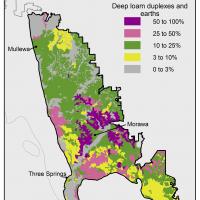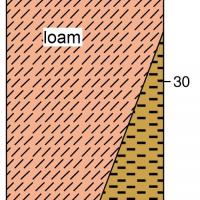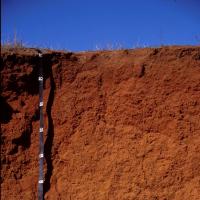Summary
| Occurrence | Mullewa to Morawa (15%) |
|---|---|
| Soil Groups of Western Australia (WA) | 505 Brown deep loamy duplex 506 Red deep loamy duplex (York Gum soil) 541 Brown loamy earth 544 Red loamy earth (Red loam) |
| Also known as | York Gum soil, Red loam |
| Australian soil classifications | Mesotrophic Red or Brown Kandosol, Mesotrophic Red or Brown Dermosol 505, 506 – Yellow, Brown or Red Chromosol, Yellow, Brown or Red Sodosol 541, 543, 544, 545 – Brown, Red or Yellow Kandosol, Brown or Red Dermosol, Red or Brown Ferrosol |
Distinguishing features
Topsoil
Red or brown hard-setting loam.
Acid to neutral pH.
Subsoil
- Neutral (505,506,541) to alkaline (542) pH.
- Loams (505,506) grading to clays (541, 542).
- Calcareous nodules (506, 542) or Ironstone gravels may be present (541).
Constraints
The following data has been derived from actual site samples taken. These results are recorded in this Excel spreadsheet.
| Rating | Implications |
|---|---|
| Not applicable (n/a) | No constraints identified |
| Minor | Minor constraint - reduces crop yields in some years |
| Major | Major constraint - reduces crop yields in most years |
| Severe | Severe constraint - will always reduce crop yields |
| Soil Group of WA | 541 Brown loamy earth* | 541 Brown loamy earth* | 544 Red loamy earth* | 544 Red loamy earth* |
| Constraints | Topsoil | Subsoil | Topsoil | Subsoil |
| Acidity and aluminium toxicity | Minor | Minor | n/a | n/a |
| Salinity | n/a | Minor | n/a | n/a |
| Sodicity and alkalinity | n/a | Minor | n/a | Minor |
| Boron toxicity | n/a | n/a | n/a | n/a |
| Poor nutrient retention | n/a | n/a | n/a | n/a |
| Aggregate stability | n/a | Minor | n/a | Minor |
| Compaction and hard layers | Minor | Minor | Minor | Minor |
| Hard setting and crusting | Minor | n/a | Minor | n/a |
| Water repellence | n/a | n/a | n/a | n/a |
| Low plant available water | n/a | Minor | n/a | n/a |
| Water-logging (seasonal) | n/a | Minor | n/a | Minor |
| Wind erosion (seasonal) | n/a | n/a | n/a | n/a |
| Water erosion (seasonal) | Minor | n/a | Minor | n/a |
*Note - Data derived from site identifications (ID's).
- Soil Group of WA - 541 Brown loamy earth site ID includes: TSL 0321, GTN 1416.
- Soil Group of WA - 544 Red loamy earth site ID includes: GTN 2002, GTN 1407.
Further information
Agriculture Western Australia (1997) Soil Information Sheets for the Northern Agricultural Areas. Miscellaneous Publication 13/97. Agriculture Western Australia.
McArthur, WM (2004) Reference Soils of South-western Australia (Reprint). Department of Agriculture, Western Australia.
Moore, G (2004) Soil Guide: A Handbook for Understanding and Managing Agricultural Soils. Bulletin 4343. Department of Agriculture, Western Australia.
Rogers, LG (1996) Geraldton Region Land Resource Survey. Land Resources Series No. 13. Agriculture Western Australia.
Stoneman, TC (1990) An Introduction to the Soils of the Geraldton Advisory District. Bulletin 4181. Western Australian Department of Agriculture.
Schoknecht, N and Pathan, S (2013) Soil Groups of Western Australia. Resource Management Technical Report 380. Department of Agriculture and Food, Western Australia.




